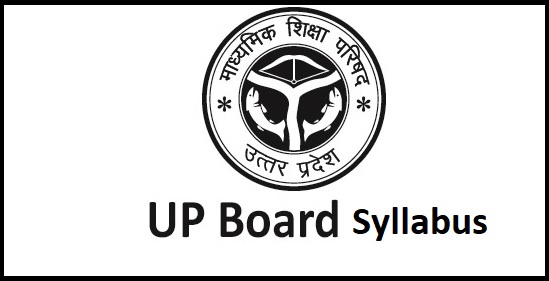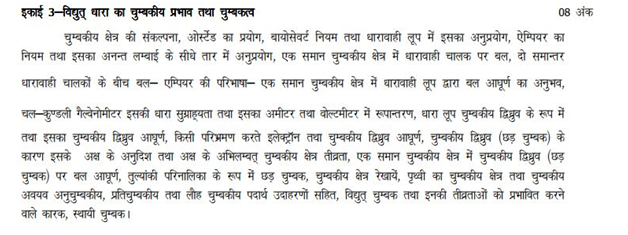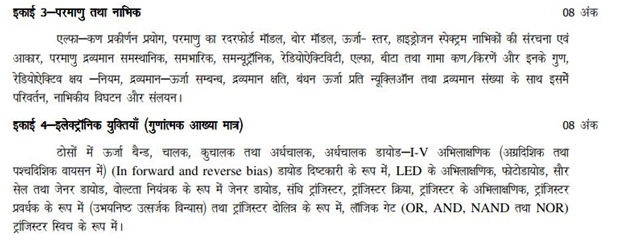UP Board Class 12 Physics Syllabus 2024-25 (भौतिकी का सिलेबस)- Released

Physics is one of the most important subjects for the students who are going to appear for the UP board exam with science stream. It is considered one of the toughest yet high-scoring subjects. The aspiring candidates should know and get familiar with the UP Board Class 12 Physics syllabus 2024-25 in order to prepare for the exam in a better way. Understanding the concept of class 12th physics will not only help you in clearing the class 12th exam but help you in various entrance exams as well.
यूपी बोर्ड 12 वीं कक्षा के भौतिकी विषय का प्रश्न पत्र 70 अंकों का होगा और 30 अंक प्रायौगिक (practical) के आधार पर दिए जाएंगे। हम इस पोस्ट में यूपी बोर्ड 12 वीं कक्षा के भौतिक विज्ञान विषय का सिलेबस प्रदान कर रहे हैं।
Before checking the unit wise syllabus of UP Board Class 12th physics, you should understand the exam structure as given below.
| Unit | Title | Maximum marks |
| Part – A | ||
| 1 | Static Electricity स्थिर विद्युतकी | 08 |
| 2 | Current Electricity धारा विद्युत | 07 |
| 3 | Magnetic Effect of Current and Magnetism धरा का चुम्बकीय प्रभाव और चुम्बकत्व | 08 |
| 4 | Electromagnetic induction and reversible current विद्युत चुम्बकीय प्रेरण तथा प्रतिवर्ती धराये | 08 |
| 5 | Electromagnetic waves विद्युत चुम्बकीय तरंगे | 04 |
| Part – B | ||
| 1 | Optics प्रकाशिकी | 13 |
| 2 | Dual nature of matter and radiation द्रव्य और द्वैत प्रकृति | 06 |
| 3 | Atoms and nuclei परमाणु तथा नाभिक | 08 |
| 4 | Electronic Devices इलेक्ट्रॉनिक युक्तियाँ | 08 |
| Total | 70 marks | |
Unit Wise UP Board 12th Class Syllabus of Physics Subject
Part – A
Unit – I: Static Electricity
Electric charge, conservation of charge, Coulomb’s Law – force between two point charges, force between many charges, super imposition principle and continuous distribution of charge
Electric field, Electric field due to electric charge, electric field lines, electric field due to electric dipole, Force on electric dipole in constant electric field
Gauss’s law statement and application of this rule in finding electric field in a uniformly charged straight wire of infinite length, a uniformly charged infinite plane sheet and a uniformly charged thin spherical shell, Electric potential, potential difference, point charge, electric dipole, Electric potential due to body of charges, connection of capacitor is series and parallel, bound charge and free charge in a conductor, etc.
Unit – 2: Current Electricity
Electric current, flow of electric charge in metallic conductor, Drift velocity, mobility and its relation with current, ohm’s law, electric resistance V-I characteristics (Linear and non-linear), electric energy and power, electric resistivity and conductivity, Carbon resistor, color code for carbon resistor, categories of resistor, thermal dependency of resistance, Internal resistance of a cell, EMF and potential difference of a cell, etc.
Unit – 3: Magnetic Effect of Current and Magnetism
Concept of magnetic field, oersted’s experiment, biot-savart’s law in a ring of charge, Ampere’s law and its application in a wire of infinite length, Force on electric conductor in constant magnetic field, Force between two parallel electric conductor, Definition of Ampere, Floating coil galvanometer – its electric sensitivity and transformation into Ammeter and voltmeter, magnetic moment on a moving electron, Rod magnet in the form of a synchronous solenoid, magnetic field lines, Earth’s magnetic field, Antimagnetic and ferromagnetic materials, etc.
Unit – 4: Electromagnetic induction and reversible current
Faraday’s law of electromagnetic induction, Induced EMF and current, Lange’s law, self induction and mutual induction, Alternating current, Peak and square median value of alternating current & voltage, Reactance and impedance, LC Oscillation, series LCR circuit resonance, AC circuit resonance, etc.
Unit – 5: Electromagnetic waves
The requirement of displacement current, electromagnetic waves, and their characteristics (qualitative concept only) electromagnetic, transverse nature of waves, electromagnetic spectrum, etc.
Part – B
Unit – 1: Optics
Reflection of light, spherical mirrors, mirror formulas, refraction of light, full internal reflection and its applications, Optical fibers, refraction on spherical surfaces, lenses, formula for thin lenses, lens maker formulas, magnification, power of lenses, combination of thin lenses in contact, combination of lenses and mirrors, refraction and reflection of light through a prism.
Light scattering – Blue color of the sky, Sun’s red color visible in the sky at sunrise and sunset, Optical instruments – human eye, image formation and adjustment capability, correction of vision defects by lenses, etc
Unit – 2: Dual nature of matter and radiation
Dual nature of radiations, lightning effect, Hertz and Leonard observation, Einstein light electromagnetic equation, the particle nature of light, the transverse nature of EM waves, De-Broglie relation, Davison and German experiments (experimental details should not be given only explain the conclusion).
Unit – 3: Atoms and nuclei
Alpha-particle scattering experiment, Rutherford model of atom, bohr’s model, energy level, structure and shape of hydrogen spectrum nuclei, Atomic mass isotopic, isobaric, Samneutronic, radioactivity, alpha, beta and gamma particles / rays and their properties, Radioactive decay – law, mass-energy relationship, mass loss, bond energy per nucleon and its change with mass number, nuclear dissolution and fusion.
Unit – 4: Electronic Devices
Energy bands, conductors, conductors and semiconductors, semiconductor diode-I-V characteristics (in forward and reverse bias), diode as a rectifier, LED characteristics, photodiodes, solar cells and Zener diodes, Zener diodes as voltage controllers, transistors, transistor working, transistor characteristics, transistor as an amplifier etc.
UP Board 12th Physics Practical Examination 2024
The structure of UP Board class 12th Practical exam is given in the table below.
यूपी बोर्ड कक्षा 12 वीं भौतिकी प्रैक्टिकल परीक्षा की संरचना नीचे दी गई तालिका में दी गई है।
| Particulars | Maximum Marks |
| External assessment वाह्य मूल्यांकन | |
| Any two experiments कोई भी दो प्रयोग | 10 (5 x2) |
| Viva based on experiments प्रयोगों के आधार पर मौखिक परीक्षा | 05 |
| Internal Assessment आंतरिक मूल्यांकन | |
| Practical Record प्रायौगिक रिकॉर्ड | 04 |
| Project work and viva based on project प्रोजेक्ट कार्य और उस पर आधारित मौखिक परीक्षा | 08 |
| Assignment – continuous assessment सत्रीय कार्य – सतत मूल्यांकन | 03 |
| Total | 30 |
UP Board 12th Physics List of Experiments
Part – A: Experiment’s list
- चल–सूक्ष्मदशी द्वारा कांच के गुटके का अपवर्तनक ज्ञात करना।
- समतल दर्पण तथा उत्तल लेंस द्वारा किसी द्रव का अपवर्तनांक ज्ञात करना।
- अवतल दर्पण के प्रकरण में u के विभिन्न मानों के लिये v का मान ज्ञात करके अवतल दर्पण की फोकस दूरी ज्ञात करना।
- अमीटर तथा वोल्टमीटर द्वारा ओम के नियम का सत्यापन करना तथा तार के पदार्थ का विशिष्ट प्रतिरोध ज्ञात करना।
- उत्तल लेंस का उपयोग करके उत्तल दर्पण की फोकस दूरी ज्ञात करना।
- u तथा v अथवा 1/u तथा I/v के बीच ग्राफ खींचकर किसी उत्तल लेंस की फोकस दूरी ज्ञात करना।
- उत्तल लेंस का उपयोग करके अवतल लेंस की फोकस दूरी ज्ञात करना।
- दिये गये प्रिज्म के लिये आपतन कोण तथा विचलन कोण के बीच ग्राफ खींचकर न्यूनतम विचलन कोण ज्ञात करना तथा प्रिज्म के पदार्थ का अपवर्तनांक ज्ञात करना।
- मीटर सेतु द्वारा किसी दिये गये तार का प्रतिरोध ज्ञात करके उसके पदार्थ का विशिष्ट प्रतिरोध ज्ञात करना।
- मीटर सेतु द्वारा प्रतिरोधकों के (श्रेणी/समान्तर) संयोजनों के नियमों का सत्यापन करना।
- वोल्टमीटर तथा प्रतिरोध बॉक्स की सहायता से किसी सेल का आन्तरिक प्रतिरोध ज्ञात करना।
Part B – List of Experiments
- विभवमापी द्वारा दो दिये गये प्राथमिक सेलों की विद्युत् वाहक बलों की तुलना करना।
- विभवमापी द्वारा दिये गये प्राथमिक सेल का आन्तरिक प्रतिरोध ज्ञात करना।
- विस्थापन विधि से उत्तल लेंस की फोकल दूरी ज्ञात करना।
- अर्द्ध विक्षेपण विधि द्वारा धारामापी का प्रतिरोध एवं दक्षतांक ज्ञात करना।
- दिये गये धारामापी (जिसका प्रतिरोध एवं दक्षतांक ज्ञात हो) को वांछित परिषर अमीटर से रूपान्तरण करना।
- दिये गये धारामापी को वांछित परिषर के वोल्ट मीटर में रूपान्तरित करना।
- जेनर डायोड का अभिलक्षणिक वक्र खीचना।
- P-N डायोड का अभिलक्षणिक वक्र खीचना एवं अग्रअभिनति प्रतिरोध ज्ञात करना।
- जेनर डायोड के अभिलक्षणिक वक्र की सहायता से उत्क्रम भंजन वोल्टता ज्ञात करना।
- किसी उभयनिष्ठ-उत्सर्जकऊ 9797 अथवा 70 ट्रॉजिस्टर के अभिलाक्षणिकों का अध्ययन करना तथा धारा एवं वोल्टता लाब्धियों के मान ज्ञात करना।
Also Check
UP Board Class 12 Biology Syllabus
UP Board Class 12 Chemistry Syllabus
UP Board Class 12th Mathematics Syllabus
UP Board Class 12 English Syllabus










Ram ram bhut achcha
Really
Thank you sir
Nice
Thank u sir
Really this is too good information to all students.
Right 👍
Madam/sir
Mujhe physics m Lead krne k liye help chahiye please
Thanks good information
THQ soo much sir
Your information is very helpful for students
Can any one help me please
Which topic are reduced from our syllabus, because I don’t know what I study or not.
Please share the reduce syllabus in up board english medium.
And please share in english.
Thank you.
By the way good information but I need reduce syllabus. I understood little bit.
Aapko pta chla reduce syllabus phy ka
good
thank’s
hii
Is this..for…the students of academic year 2021-22 ?
Please .. assure…🙏
Maybe
hii ananyaa i am gaurav tiwari i love you and want talk you please you reply me your number
Yes you are you a student of up board
Thank you very much for provide physics syllabus
Nice
A good decision in this time
मुझे भौतिक विज्ञान जीव विज्ञान रसायन विज्ञान की जानकारी चाहिए
Hi up board ka solutions maths paper
Iske liye aapko kitabein pdni chahiye
Thank you sir
ऐसे समय में इस बहुमूल्य जानकारी के लिए आपकी पूरी टीम को बहुत-बहुत धन्यवाद।
Thank you so much for your valuable feedback!
Good information . Thanku sir
Thank you for sharing your feedback!
Achchhi information hai. Thanku sir
Thank you so much for your valuable feedbaack!
A good information
Good information
Thank you!